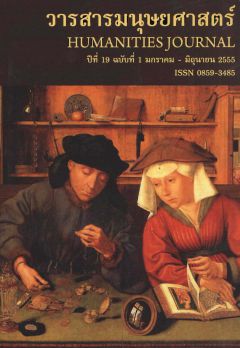ข้อสังเกตในการใช้แบบตัวพิมพ์ไทยเสมือนโรมัน: เอกลักษณ์และความชัดเจนที่หายไป
Main Article Content
Abstract
บทความนี้มีวัตถุประสงค์เพื่อนาเสนอข้อสังเกตเบื้องต้นในการใช้แบบตัวพิมพ์ไทยเสมือนโรมัน โดยเฉพาะแบบตัวพิมพ์ไทยเสมือนโรมันชนิดแซนส์เซอริฟที่ส่งผลกระทบต่อการสื่อสารด้านประจักษภาพและการอ่านเข้าใจในสื่อต่างๆ ซึ่งจะนาไปสู่การเปิดประเด็นการถกเถียงในวงกว้างเพื่อการพัฒนาทฤษฎีทางศิลปะการใช้ตัวพิมพ์และการออกแบบตัวพิมพ์ของไทย โดยผู้ศึกษาได้ทาการสารวจการใช้แบบตัวพิมพ์ดังกล่าวที่ปรากฏในสื่อกราฟิก 4 ประเภท ได้แก่ กราฟิกสิ่งพิมพ์,กราฟิกบนบรรจุภัณฑ์, กราฟิกบนหน้าจอ, และกราฟิกสิ่งแวดล้อม ผลการศึกษาพบว่า การใช้แบบตัวพิมพ์ไทยเสมือนโรมันในฐานะตัวพิมพ์เนื้อหา โดยใช้ในขนาดเล็ก ประกอบกับการจัดแนวตัวพิมพ์แบบเสมอหน้า-หลัง ถือเป็นการใช้ตัวพิมพ์ที่ผิดหลักการเพื่อการอ่าน ส่งผลต่อประจักษภาพและการอ่านเข้าใจ ทั้งนี้เมื่อวิเคราะห์ถึงสาเหตุการนาแบบตัวพิมพ์ไทยเสมือนโรมันไปใช้งานในเนื้อหา พบว่า มีสาเหตุสาคัญ 4 ประการ คือ 1) ความรู้สึกว่าทันสมัยและการนิยมใช้ตามๆ กัน เพราะตัวพิมพ์ดังกล่าวดัดแปลงมาจากตัวอักษรโรมัน และถูกให้ความหมายว่าทันสมัยกว่าตัวพิมพ์ไทยมาตรฐานซึ่งถูกให้ความหมายว่าเป็นไทย และถูกมองว่าล้าหลัง 2) ข้อจากัดและอิทธิพลทางธุรกิจ โดยเฉพาะสื่อโฆษณาสินค้าต่างๆ ที่มีการกากับควบคุมทิศทางอัตลักษณ์แบรนด์ ซึ่งอาจถูกกาหนดมาจากบริษัทแม่ในต่างประเทศและเปลี่ยนแปลงได้ยาก 3) จงใจใช้เพื่อไม่อยากให้อ่าน เป็นการอาพรางข้อมูลต่อผู้บริโภค จะปรากฏชัดเจนในกรณีการให้ข้อมูลเกี่ยวกับโภชนาการของสินค้า หรือข้อตกลง/เงื่อนไขในการซื้อสินค้าและบริการต่างๆ ที่มักจะใช้ตัวพิมพ์ไทยเสมือนโรมันในขนาดเล็ก จัดวางแบบมีความยาวบรรทัดมากเกินไปส่งผลทาให้ผู้บริโภคไม่อยากอ่านข้อมูลดังกล่าว ซึ่งผู้ศึกษามองว่าเป็นประเด็นทางจริยธรรมทางการออกแบบที่สาคัญของนักออกแบบที่ควรคานึงถึง 4) แนวคิดหัวก้าวหน้าและความเชื่อ เป็นกลุ่มที่มองว่าตัวพิมพ์ที่มีอยู่สามารถเปลี่ยนแปลงได้ หากใช้แบบตัวพิมพ์ไทยเสมือนโรมันอย่างต่อเนื่อง คนจะคุ้นชินและสามารถอ่านได้เอง ทั้งนี้ ผู้ศึกษามองว่าเป็นประเด็นที่ต้องมีการพิสูจน์เชิงประจักษ์ผ่านกระบวนการศึกษาวิจัยอย่างเป็นระบบสืบไป
Viewpoint of Using a Roman-like Typeface: Disappearance of Singularity and Legibility
Rachapoom Punsongserm
The objectives of this assignment are to introduce the primary observations of using a roman-like Thai typeface, specifically the roman-like type face known as “Sans serif” and its effects on legibility and readability in various types of communication. This can be applied to opening the debate in order to develop a broad theory on the development of typography and typeface design of Thai fonts. The researcher undertook a survey using the typeface mentioned which was displayed as 4 types of graphic media; publication graphic, graphic on package; graphic on screen; and environmental graphic. The results of the survey found that the use of the roman-like typeface as the main body of text when used in a small font size as well as being justified and in bold the typeface as considered the case for the principle of reading; this had an effect on both the legibility and readability. So the results of the research in using the roman-like typeface as the main body text found that there are 4 causes as follows; 1) It feels like it is more popular to use and more modern because the typeface mentioned is taken from the roman typeface and this gives it a more advanced feel than the Thai case which is seen as being more backwards. 2) The limitations and influence in business especially in areas of advertising various products with the direction the brand identity, which may be assigned from the parent company in another country and change it. 3) It is used deliberately when they don’t want the information to be read for the concealment of information to consumers. This is shown clearly in the case of a product's nutritional information or terms / conditions in the purchase of goods and services. Roman typeface is often used in a small font size and a long line length placement, resulting in the majority of consumers not wishing to read it. The researcher sees this as an important ethical issue of design, designers must take into account. 4) Progressive ideas and beliefs; there are those that believe existing typefaces should be adapted and that if the Thai typeface is to be continually Romanized then people will become more accustomed to reading it. The researcher thinks that this is an issue that needs to be investigated through further empirical evidence.


